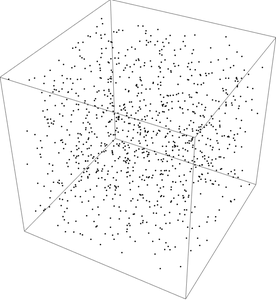Expected distance between points in a cube

Suppose you randomly sample points from a unit cube. How far apart are pairs of points on average?
My intuition would say that the expected distance either has a simple closed form or no closed form at all. To my surprise, the result is somewhere in between: a complicated closed form.
Computing the expected value by simulation is straight forward. I'll make the code a little less straight forward but more interesting and more compact by leveraging a couple features of NumPy.
import numpy as np dimension = 3 reps = 10000 cube1 = np.random.random((reps, dimension)) cube2 = np.random.random((reps, dimension)) distances = np.linalg.norm(cube1 - cube2, axis=1) print(distances.mean())
This gives a value of 0.6629. This value is probably correct to two decimal places since the Central Limit Theorem says our error should be on the order of one over the square root of the number of reps.
In fact, the expected value given here is
which evaluates numerically to 0.661707....
The expression for the expected value is simpler in lower dimensions; it's just 1/3 in one dimension. In higher dimensions there is no closed form in terms of elementary functions and integers.
Incidentally, the image above was made using the following Mathematica code.
pts = RandomPoint[Cube[], 10^3]; Graphics3D[{PointSize[Small], Point[pts], Opacity[0.3]}, Boxed -> True]The post Expected distance between points in a cube first appeared on John D. Cook.